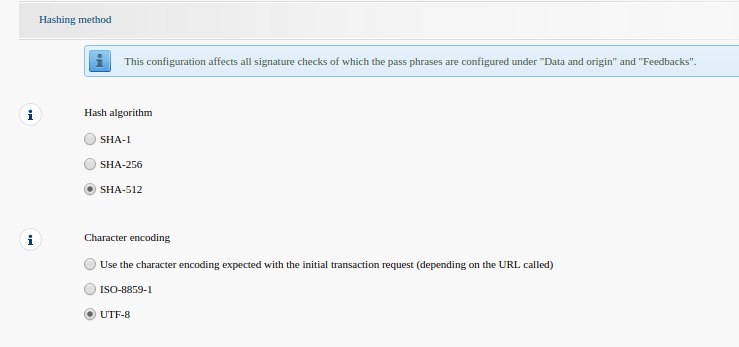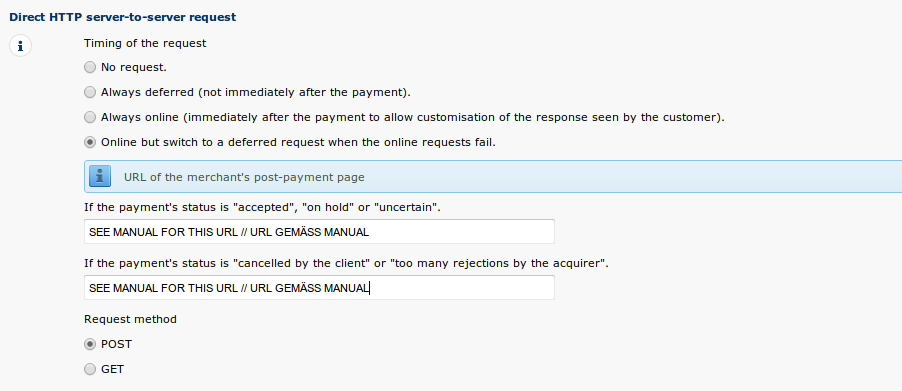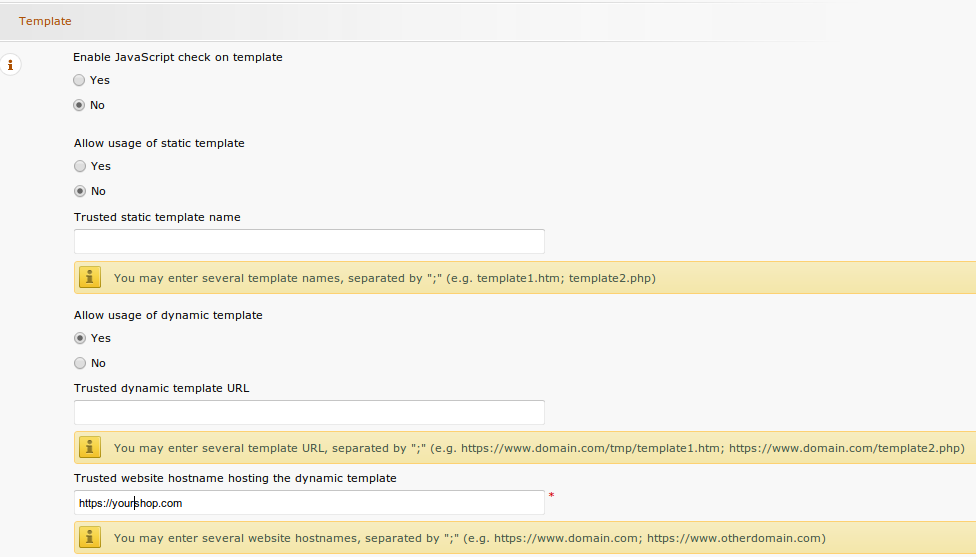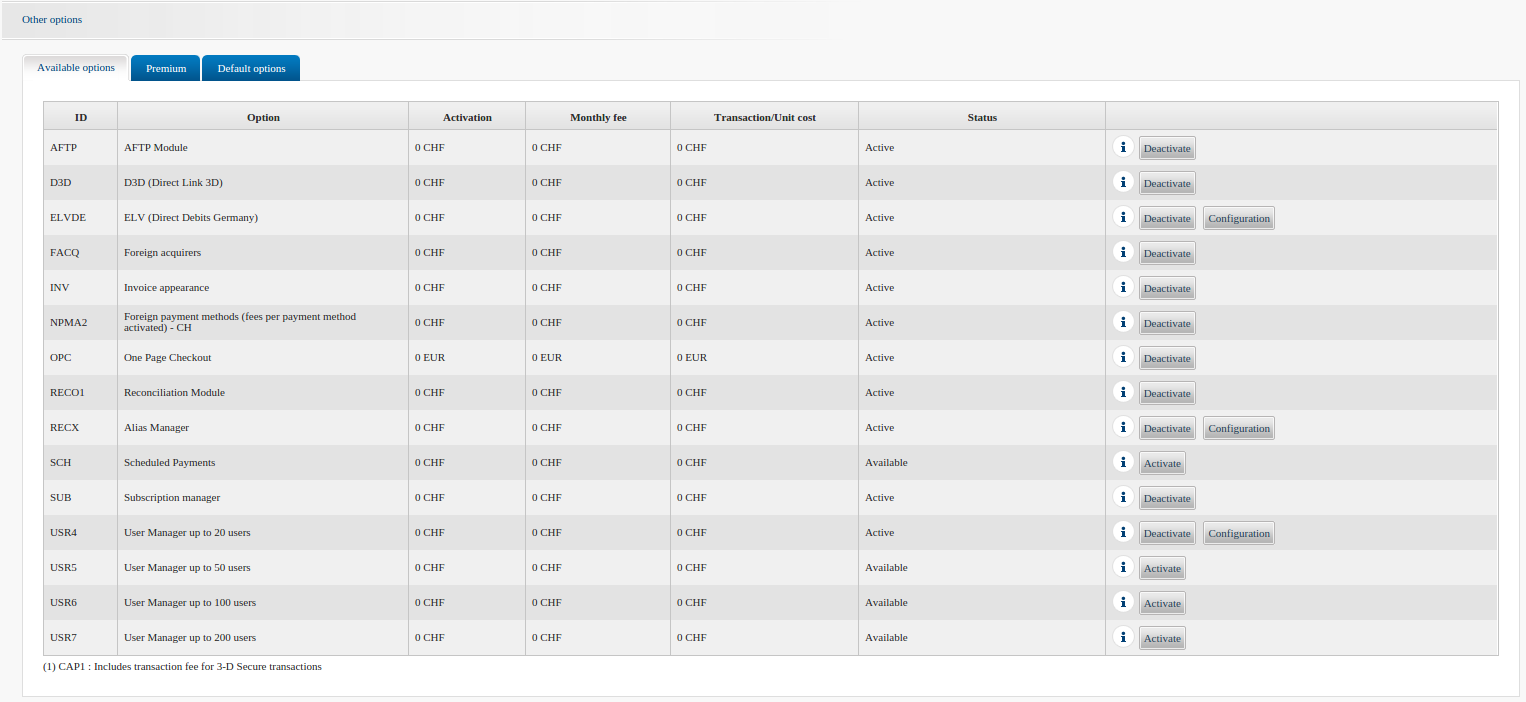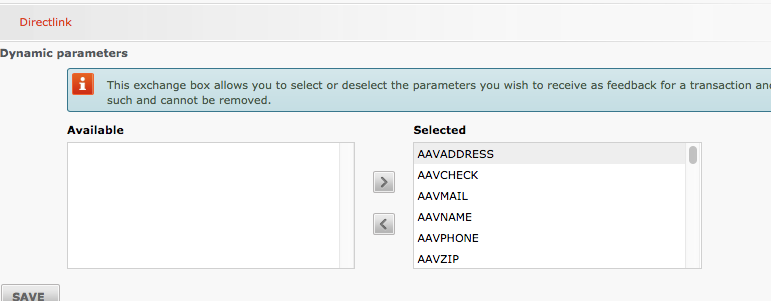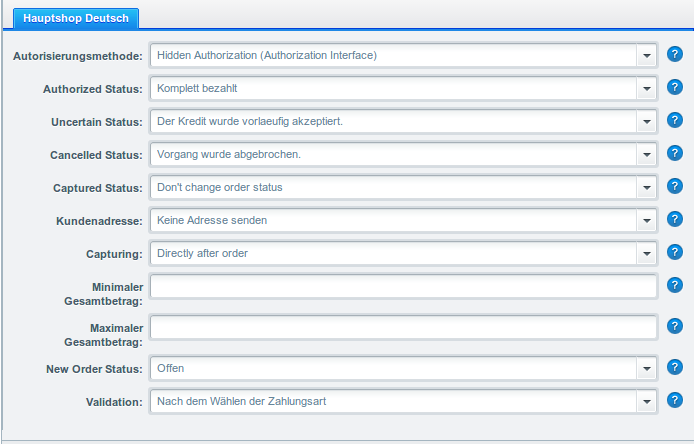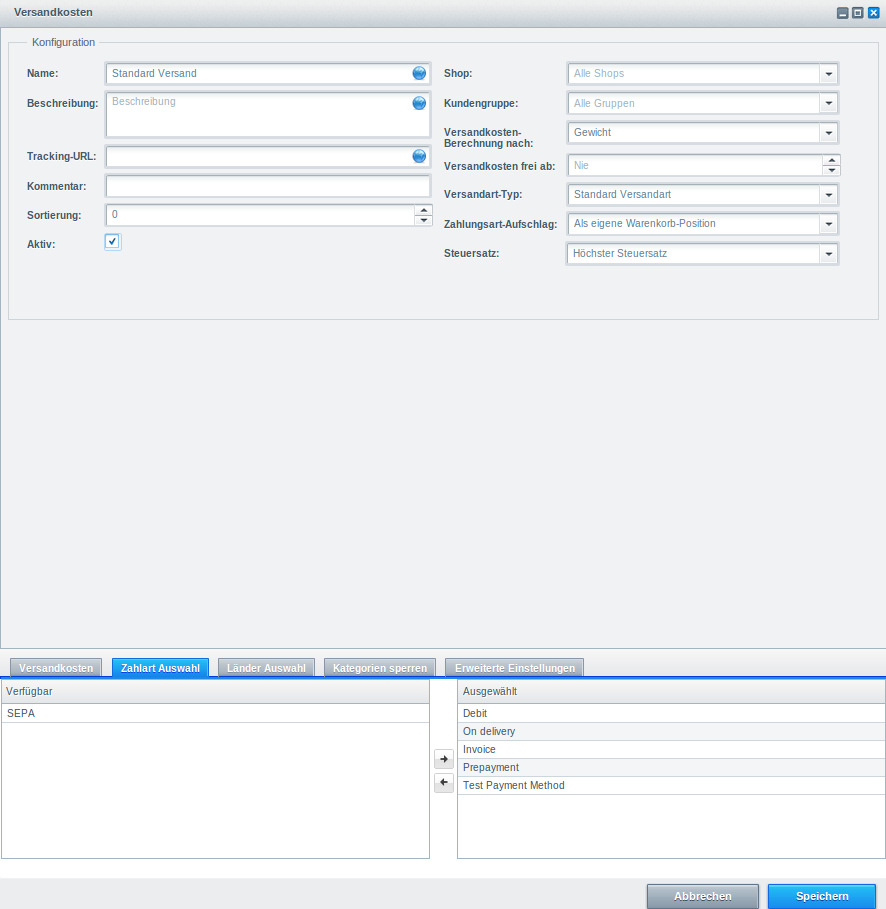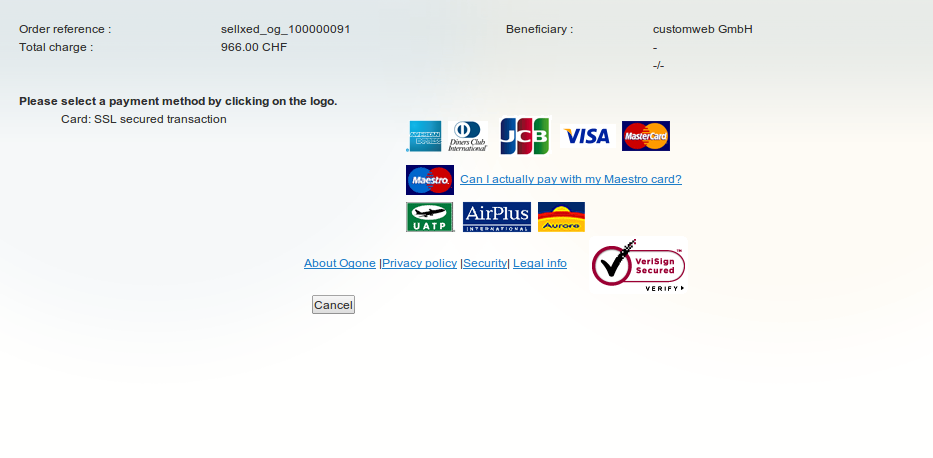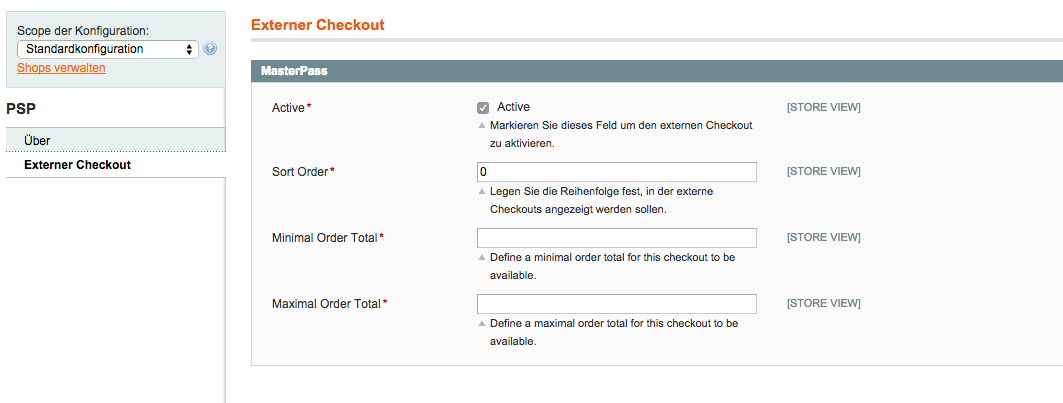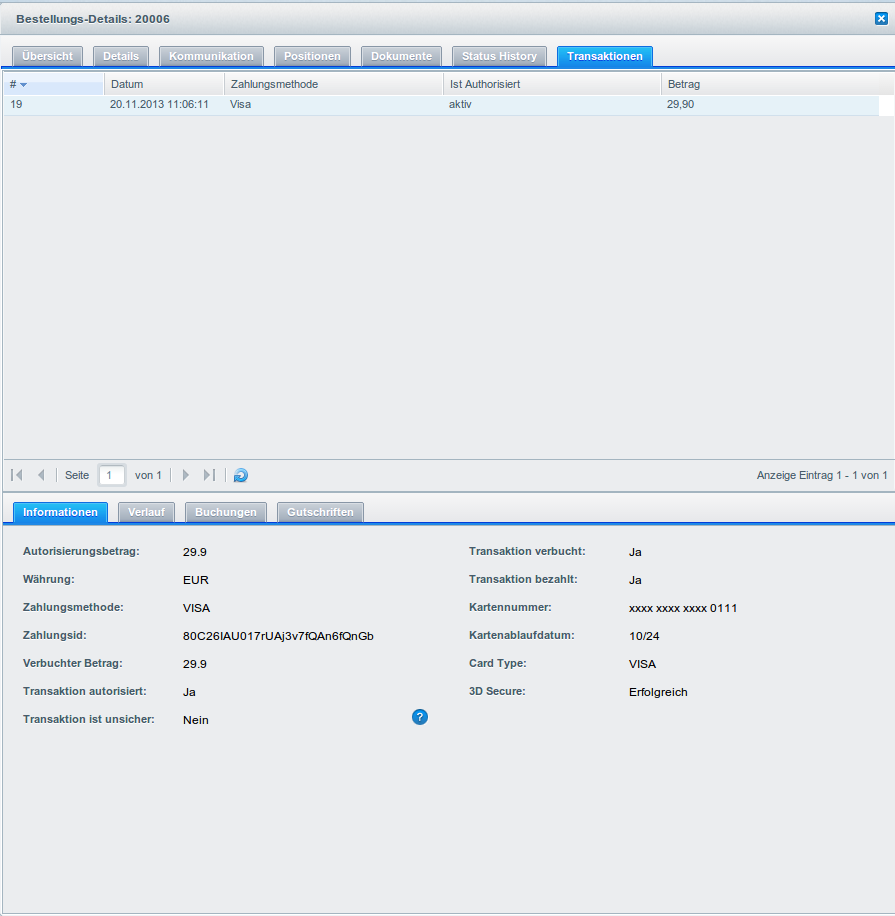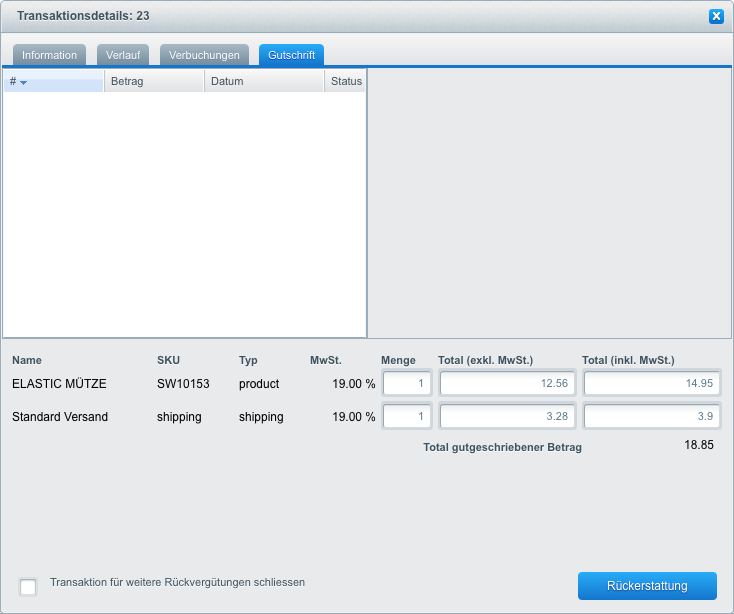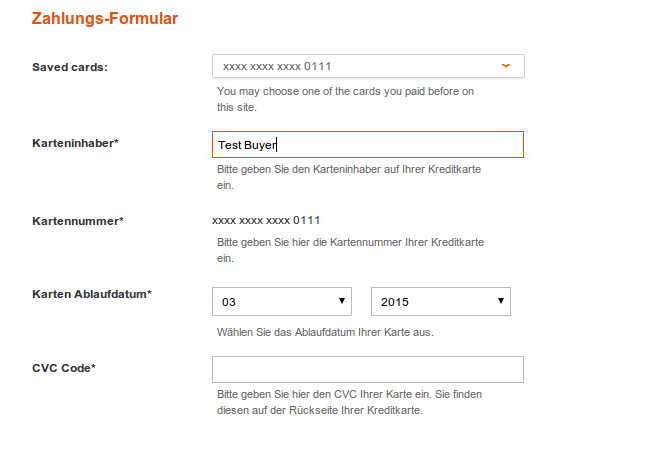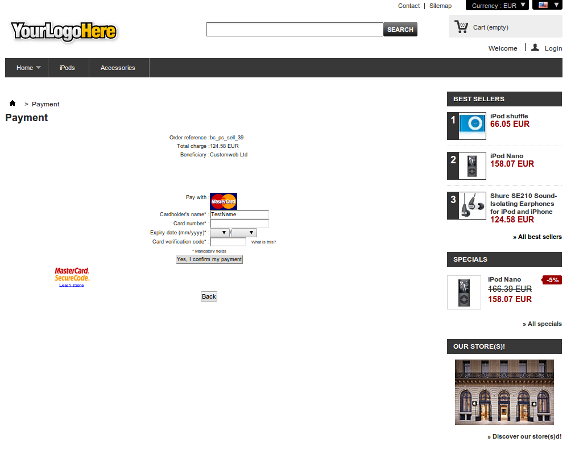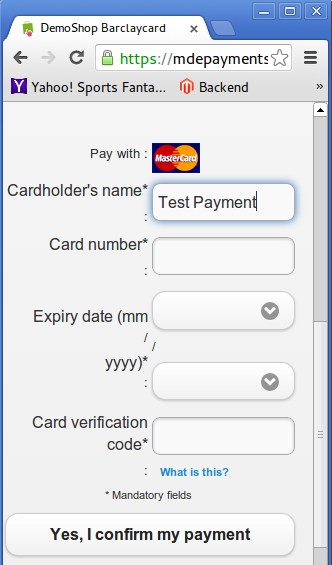1Introduction
This manual explains the installation, configuration and usage of the payment module for Shopware and Concardis PayEngine. It is important that you strictly follow the described steps. Only by doing so, a secure usage in compliance with all security regulations can be guaranteed.
Before beginning with the installation, please make sure that you are in possession of all necessary data:
- PSPID & Password. You receive these credentials from Concardis PayEngine after conclusion of contract. Our support staff is happy to help you acquiring a Concardis PayEngine contract if you do not yet have one.
- Shopware payment module from sellxed.com/shop
- FTP access to your server
- Login credentials for your shop
Note that you must use at least PHP version 5.6 for our plugins. PHP 8 or higher is currently not supported.
1.1Procedure of the Installation
- Configuration of the administration interface of Concardis PayEngine.
- Upload of the module
- Configuration of the basic settings of the payment module
- Configuration of the payment methods
- Carrying out a test purchase by means of the attached test data at the end of this document
- If the test was successful, copy all data from your test account into the Concardis PayEngine live account.
Our payment plugins should have per default the correct settings for most of our customers' preferences. That means once you have entered the required credentials in the plugin configuration to connect your account to your website, the plugin should be fully operational. Should you be willing to receive detailed information on a setting you do not know, you may contact our support team who will be able to assist you further.
Our support team is at your disposal during regular business hours at: http://www.sellxed.com/support. Furthermore, you have the option of ordering our installation service. We will make sure the plugin is installed correctly in your shop: http://www.sellxed.com/shop/de/integration-und-installation.html
In order to test the module, any kind of directory protection or IP blocking on your server must be deactivated. This is crucial as otherwise the payment feedback of Concardis PayEngine might not get through to the shop.
1.2System Requirements
In general, the plugin has the same system requirements as Shopware. Below you can find the most important requirements of the plugin:- PHP Version: 5.4.x or higher
- OpenSSL: Current version with support for TLS 1.2 or higher.
- fsockopen: The PHP function fsockopen must be enabled. The plugin must be able to connect to external systems over the Internet.
- PHP Functions: All common PHP functions must be enabled.
2Configuration Concardis PayEngine - Backend
For the configuration, log into the Concardis PayEngine backend:
- Test Environment: https://secure.payengine.de/ncol/test/backoffice
- Live Environment: https://secure.payengine.de/ncol/prod/backoffice
The settings carried out on the following pages are a precondition for the configuration of the main module.
The configuration of the settings is done under Configuration > Technical Information. In the following chapter the chapter titles correspond to the tabs in the back office of Concardis PayEngine. For some parts screenshots will be added for a more precise illustration. Should a specific setting not be mentioned then it has no importance for the configuration of the payment module and can be ignored by you as such.
2.1Tab: Global Transaction Parameters
Under the tab Global Transaction Parameters you define the basic settings for the processing of transactions.
2.1.1Default operation code and default data capture procedure
We recommend choosing Sale and "Automatic data capture by our system at the end of the day". All incoming payments will be directly processed and debited. If you are using transaction management and deferred capturing we strongly advise to use these settings. In case you have saved different settings in the module, then the module's settings will overwrite those of the Concardis PayEngine.
2.1.2Payment Retry
We recommend entering 10.
2.1.3Processing for Individual Transactions
We recommend the option "Online but switch to offline when the online acquiring system is unavailable"".
2.2Tab: Global Security Parameters
Here you define the security parameters for the interaction between your shop and the gateway of Concardis PayEngine.
2.2.1Hashing Method
The sellxed payment modules support all hashing methods. In order for the module to function, it is crucial that the settings saved with Concardis PayEngine correspond to those made in the backend of your shop.
In order to guarantee a smooth processing of payments, we recommend the following hashing methods:
- Each parameter, followed by the pass phrase. It may be that this parameter is not visible in your shop. In this case it is transmitted automatically.
- Hash Algorithm = SHA 512
- Character Encoding = UTF-8
These settings must be identical to the settings in the main module (cf. Configuration of the main module). Please note that the character encoding in our modules is set to UTF-8 per default and cannot be changed.
2.3Tab: Payment Page
The checkbox under Cancel Button should be ticked. The field under Back Button Redirection can be left empty.
2.4Tab: Data and Origin Verification
The tab Data and Origin Verification defines security elements concerning the transmission of data and the loading of the payment page.
2.4.1Checks for e-commerce & Alias Gateway
The first box under "URL of the merchant page" can remain empty.
The box "SHA-IN pass phrase" is a security element of the payment verifying its authenticity. Therefore it is important that you use the same pass phrase in the back end and in the shop.
Please note that only ASCII characters may be used for SHA pass phrases. Please use our SHA pass phrase generator so that you do not enter invalid characters.
2.4.2Checks for Concardis PayEngine DirectLink and Concardis PayEngine Batch (Automatic)
DirectLink allows you to use the Hidden Authorisation (Alias Gateway) as well as the direct debiting of transactions within your shop. If you have activated DirectLInk in your account and wish to use this feature, enter the same SHA-IN pass phrase in the box "SHA-IN pass phrase" as above.
Further information on the configuration of DirectLink can be found under Configuration Hidden Authorisation.
2.5Tab: Transaction Feedback
In the tab Transaction Feedback the response of Concardis PayEngine to the shop is controlled.
2.5.1HTTP Redirection in the Browser
The parameters in the transaction feedback determine the processing in the shop after payment has been completed. However, the four fields for "HTTP Redirection in the Browser" can remain empty because they will be configured through the settings of our module.
Un-tick the option "I would like Concardis PayEngine to display a short text to the customer on the secure payment page if a redirection to my website is detected immediately after the payment process."
2.5.2Direct HTTP-Server-to-Server-Request
- The "Timing of the Request" must be set to Online but switch to a deferred request when the online requests fail. As "Request Method" you must select "POST".
- In the section General make sure that the Option: "I would like Concardis PayEngine to display a "processing" message to the customer during payment processing." is un-ticked too.
- Copy here the URL that is listed in the module backend under: Configuration > Concardis PayEngine > Setup.
URL on which the merchant wishes to receive a deferred HTTP request, should the status of a transaction change offline.
For the Transaction Feedback please enter the URL that is generated in the main module. More information can be found under the section Transaction Feedback
Should you notice during the tests that orders are not registered in the shop and that no confirmation email is sent, this might be due to a failure of the transaction feedback. Make sure that your firewall is not blocking any request coming from Concardis PayEngine.
Concardis PayEngine sends the notification requests with a time out of 20 sec. Should your shop not respond to the HTTP Request within this time, a time out error will be sent. If you set the option to Online but switch to a deferred request when the online requests fail the request will be retrieved four times in ten minute intervals.
Please note that, depending on your Concardis PayEngine subscription, it is possible that the only option available is Always online (immediately after the payment to allow customization of the response seen by the customer). In this case, always select this option.
2.5.3Dynamic e-Commerce Parameters
With this option you control which parameters are sent in the response from Concardis PayEngine. In order for payments to effectively be evaluated in your shop, all necessary parameters must be sent. It is possible that you have other options available to select. Just make sure that you move every parameter from available to selected except for the following:
- PM
- CN
- SUBBRAND
- AAVADDRESS
- AAVCHECK
- AAVMAIL
- AAVNAME
- AAVPHONE
- AAVZIP

2.5.4Dynamic Parameters
With this option you control which parameters are sent in the response from Concardis PayEngine. In order for payments to effectively be evaluated in your shop, all parameters must be sent. It is possible that you have other options available to select. Just make sure that you move every parameters from available to selected.

2.5.5Security for Request Parameters
The box "SHA-OUT pass phrase" is an additional safety mechanism for payments. Here too must the entered pass phrase be identical to the one in your shop. However, please make sure that your SHA-OUT pass phrase differs from the SHA-IN pass phrase. .
Please note that only ASCII characters may be used for SHA pass phrases. Please use our SHA pass phrase generator so that you do not enter invalid characters.
2.5.6HTTP Request for Status Changes
You have the option to be informed about status changes by Concardis PayEngine directly. This feature is especially useful when a payment has an uncertain status because the acquirer system could not be reached. The payment status will be updated automatically. Furthermore this feature allows you to capture payments inside Concardis PayEngine and have synchronize them with your shop
In order to use this feature you will have to select the option For each offline status change (payment, cancellation, etc.).. Afterwards just copy the URL into the field that is displayed in the Setup of your Main configuration: Configuration > Concardis PayEngine > Setup.
Enter the URL shown there into the field 'URL on which the merchant wishes to receive a deferred HTTP request, should the status of a transaction change offline.'
2.5.7Dynamic Parameters
Move all parameters from available to selected.
2.6(Dynamic-)Template
You can now find the option template via Configuration > Template. The Dynamic Template enables you to design the payment mask for the credit card data so it matches your web shop. Should the field for the dynamic template not be visible, please contact Concardis PayEngine. It may be that you have to activate additional options in your account.
For the usage of the dynamic template, please save the following settings:
- Enable JavaScript on template: 'No'
- Our modules do not allow "usage of static template". So click 'No'
- Allow usage of dynamic template: 'Yes'
- In case you are using the dynamic template, enter the host name, i.e. https://Your-Shop.com in the lower box. The upper one must remain empty.
Please note that you require an SSL certificate for the usage of the dynamic template. Otherwise the CSS-Resources will not be reloaded in certain browsers which might lead to layout issues.
The activation of the dynamic template in the shop is explained here.
2.7Hidden Authorisation, Ajax Authorization (FlexCheckout - Hosted Tokenization Page), External Checkout & Alias Manager
2.7.1Preconditions
For the usage of the Hidden Authorization, Ajax Authorization (FlexCheckout), Alias Manager or External Checkout during the payment processing, certain adjustments are necessary in the backend of Concardis PayEngine. Please check first if the options are activated in your account under Account > Your Options.
If an option is not available please contact Concardis PayEngine.
Options and their Meanings:
- For the usage of the Hidden Authorization you require the option OnePageCheckout (OPC).
- For the usage of the Ajax Authorization (FlexCheckout) you require the option OnePageCheckout (OPC) and DirectLink (DPR).
- If you additionally want to use the Alias Manager, you also need the option Alias Manager (RECX).
In case these options are not be available, please contact Concardis PayEngine directly.
2.7.2Setting Up an API-User
If you want to use the features of the transaction management or the hidden authorization (Alias Gateway) you will need to set up an API user as described herafter:
Go to Configuration > User Administration and click on 'New User'. Choose a User ID and insert a user name of your choice and your e-mail address. Select Administrator without user manager as a profile. It is furthermore important that you select the option Special user for API (no access to the administration). If you do not see this option, you will need to let Concardis PayEngine activate the option DirectLink for your account.
The User ID and the API-user password may only contain letters and numbers as wel as special characters. The following special characters are not allowed: & (Ampersand), " (double quotes), ' (single quotes)
Note down the access data. They will have to be inserted in the respective place in the configuration of the main module.
2.7.3Usage of External Checkouts
For the usage of external checkouts there are additional options required. External checkouts, such as MasterPass are payment methods, which offer the possibility to transfer addresses automatically.
The usage of the external checkouts asks for the option Direct Link and for the activation of payment method in your account.
For the performance of the payment method, you have to make sure that under Technical Information > Transactionfeedback in the section Direct Link all parameters selected are shifted
3Module Installation and Update in the Shopware Shop
3.1Installation
At this time you should already be in possession of the module. Should this not be the case, you can download the necessary files in your customer account in the sellxed shop (Menu "My Downloads Downloads"). In order to install the module in your shop, please carry out the following steps:
- Download the plugin. The download can be found in your sellxed.com account under "My Downloads".
- Unzip the archive you have just downloaded.
- In the unzipped folder navigate to the folder "files"
- For some shops there are different versions of the plugin provided. If this is the case open the folder which corresponds to your shop version.
- Using your preferred FTP client upload entire content of this folder into the root directory of your shop. For some shops there is a specific folder containing the plugins. If that is the case upload the plugin into this folder. Make sure that the folders aren't replaced but merely merged.
- If you haven't yet done so, log back into your shop.
3.2Updates and Upgrades
You have direct and unlimited access to updates and upgrades during the duration of your support contract. In order to receive constant information about available updates we ask you to subscribe to our RSS feed that we publish for your module.
More information regarding the subscription of this RSS feed can be found under: http://www.sellxed.com/en/updates_upgrades.
We only recommend an update if something doesn't work in your shop, if you want to use new feature or if there is a necessary security update.
3.2.1Update Checklist
We ask you to strictly comply with the checklist below when doing an update:
- Always do a backup for your database and your files in your shop
- Use always a test system to test the update process.
- Wait until all the files are copied to the shop, clear the cache if there is one in your shop and then visit the configuration page of the main module so that the update process will be initialized.
Please test the update procedure first in your test shop. Our support team is able and willing to help you if you experience problems with the update process. However, if you decide to perform the update directly in your live shop there is the possibility of a downtime of the shop of more than two days depending on the availability of our support if you do not want to book our complementary support.
Depending on the version it could be that the database has to be migrated. We recommend you therefore, to perform the updates in times when the shop is not visited too frequently by your customers.
3.2.2Update Instructions
Please always read the update instruction. Those instructions can be found in the changelog. If there are no special remarks, you can proceed by just overwriting the files in your system.
3.2.3Updated Plugin from the PayEngineCw to the CwbPayEngineCw Version.
We plan to release this plugin in the shopware store in the near future. To make this possible we hda to apply some changes to our code. Most important a prefix for our PHP classes is required and the plugin folder had to be renamed. To update to this new version simply overwriting the existing files is not possible. This sections describes the steps required to update the module in detail.
Please test the update procedure first in your development system. So you can ensure the update is working correctly.
If you are using multiple plugins from us. You need to update all of them to the new version.
- Activate the maintenance mode of the shop.
- Make a backup for your database and your files in your shop. Without this you will not be able to revert to the old version, if anything goes wrong.
- Upload the new plugin files.
- Deactivate the existing plugin. Do not deinstall the old plugin yet.
- Install and activate the new plugin.
- If you have custom css or template files for the plugin, adapt the changes to the new plugin.
- If you are using the Shopware API endpoint of this plugin, update the URL to new endpoint.
- Verify the main and method settings.
- Deinstall the old plugin.
- Delete the files of the old plugin. The following files/folders must be removed, if they exist:
- engine/Shopware/Plugins/Local/Frontend/PayEngineCw
- engine/Library/Customweb
- engine/Library/Crypt
- engine/Library/File
- engine/Library/Math
- engine/Library/Mobile
- engine/Library/Net
- engine/Library/PhoneNumber
- engine/Library/System
- engine/Library/loader.php
- engine/Library/openssl.cnf
- Make a test transaction to verify everything is workin correctly.
- Deactive the maintenance mode of the shop.
4Module Configuration in the Shopware Shop
The configuration consists of two steps. The first step is the configuration of the main module with all the basic settings (cf. Configuration of the Main Module). During the second step you can then carry out individual configurations for each payment method . This allows for full flexibility and perfect adaptation to your processes.
Please create a backup of the main directory of your shop. In case of problems you will then always be able to return your shop to its original state.
We furthermore recommend testing the integration on a test system. Complications may arise with third party modules installed by you. In case of questions, our support is gladly at your disposal.
4.1Configuration of the Main Module
In order to install the main module search for Concardis PayEngine under Settings > Plugin Manager . Click on the + symbol in order to begin the installation process. Afterwards, click the "edit" symbol and configure the main module.
Enter the individual options which you partly may have already used for the configuration of the administration interface of Concardis PayEngine. Should an option not be clear to you, you can click on the question mark and will find further information on the settings.
4.2Defining the URL for the Transaction Feedback
To ensure correct payment processing in your shop, at least one Feedback URL has to be provided in the Concardis PayEngine configuration. The URL to be entered can be found in your Shopware Shop under: Configuration > Concardis PayEngine > Setup > Setup
4.3Configuration of the Payment Method
After having configured the main module, you will find all payment methods under Settings > Payment Methods. Activate each payment method you wish to offer in your shop. You can save individual settings for each payment method (and for each shop in case of a multi-shop set-up) and thereby optimally adapt the payment methods to your existing processes. The most central options are described in more detail further below.
4.4Assigning the Payment Method to the Shipping Costs
In order for the transactions and the shipping costs to be matched correctly to the payment methods you need to assign the payment methods to the shipping methods. Go to settings > shipping costs. Open all the shipping costs and add a payment method.
Depending on the amount of delivered payment methods, it may be that certain payment methods can't be attributed to a specific shipping method as not all payment methods can be displayed. This is a known bug of Shopware. Merely the first 30 payment methods are displayed. Please delete all payment methods that you don't need and then all other payments will be displayed.
4.5Direct Capturing of Transactions
The option "Capture" allows you to specify if you wish to debit payments directly or if you first wish to authorise them and then debit the payment at a later point.
Depending on your acquiring contract, a reservation is only guaranteed for a specific period of time. Should you fail to debit the payment within that period, the authorisation may therefore no longer be guaranteed. Further information on this process can be found below.
It may be that settings saved in the payment modules overwrite settings saved in Concardis PayEngine.
4.6Uncertain Status
You can specifically label orders for which the money is not guaranteed to be received. This allows you to manually control the order before shipment.
4.6.1Setting the order state
For each payment method you may select in which state the order should be set to depending on the booking state. This is the initial state of the order.
4.7Optional: Validation
Note: It can be that this option is not visible in your module. In this case just ignore this section.
With the option 'Validation' you can define the moment when the payment method should be made visible to the customer during the checkout process. This setting is relevant for modules where the usage depends on the customer's compliance with specific preconditions. For example, if a solvency check has to be carried out or if the payment method is only available in certain countries. In order for the credit check or address validation to also work with European characters, the charset of the "Blowfish mode" must be set to "UTF-8" for certain PSP settings.
You have the choice between these options:
- Validation before the selection of the payment method: A validation verification is carried out before the customer selects the payment method. If the customer does not fulfill the requirements, the payment method is not displayed
- Validation after selection of the payment method: The verification of the compliance occurs after the selection of the payment method and before the confirmation of the order
- During the authorisation: The validation verification is carried out by Concardis PayEngine during the authorisation process. The payment method is displayed in any case
4.8Defining the URL for the Transaction Feedback
To ensure correct payment processing in your shop, at least one Feedback URL has to be provided in the Concardis PayEngine configuration. The URL to be entered can be found in your Shopware Shop under:Configuration > Concardis PayEngine > Setup
4.8.1Usage of the Integrated Multishop Functionality of Shopware
The payment module supports the multishop feature of Shopware. No further modifications are necessary. The module automatically recognizes the shop the order belongs to. In order for the multishop functionality to work, it is, however, necessary that the individual sub-shops within Shopware have been configured correctly.
4.8.2Usage of several independent Shopware shops
In case you wish to connect several independent shops to one contract with one contract with Concardis PayEngine, you require a sellxed payment module for each shop as well as the corresponding multi-shop module which you will find directly by the payment module.
- Extract the multi-shop module and open the file "router.php"
- Enter a shop ID of your choice in the box "Shop ID" within the main configuration of the module (e.g. shop_a and shop_b)
- Enter the following line into the corresponding place within
the file router.php of the multi-shop module (for each shop shop_a and
shop_b):
$redirect['shop_a'] = 'https://www.your-shop.com/shopware.php/sViewport,PayEngineCwProcess/sAction,process'; - Enter the URL below (instead of the URL mentioned above) under the point "Feedbacks" in the backend of Concardis PayEngine: http[s]://yourshop.com/router.php
- Copy the file router.php into the main directory of your shop
5Settings / Configuration of Payment Methods
5.1General Information About the Payment Methods
The plugin contains the most common payment methods. In case a desired payment method is not included per default, please contact us directly.
In order to be able to use a payment method, it must be activated in your account with Concardis PayEngine as well as in your shop. Information about the configuration of the payment methods can be found further above.
Below you can find important information for specific payment methods that deviate from the standard process.
5.2Information on Payment Status
For each payment method you can define an initial payment status (status for authorized payments etc.). You hereby define the payment status for each state depending on the processing type of the order (captured, authorized, etc.). It's the initial status which the order assumes. Depending on the mutation carried out by you, the status can change.
Never set the status to Pending Concardis PayEngine or any similar pending status which is implemented by the module.
5.2.1Order status "pending" / imminent payment (or similar)
Orders with the status 'pending Concardis PayEngine' are pending orders. Orders are set to that status if a customer is redirected in order to pay but hasn't returned successfully or the feedback hasn't reached your shop yet (Customer closed window on the payment page and didn't complete payment). Depending on the payment method these orders will automatically be transformed into cancelled orders and the inventory will be cleared (so long as the Cronjob is activated). How long this takes depends on the characteristics of the payment method and cannot be configured.
If you have a lot of pending orders it usually means that the notifications from your webserver to Concardis PayEngine are being blocked. In this case check the settings of your firewall and ask the Hoster to activate the IPs and User Agents of Concardis PayEngine.
5.2.2Order status "cancelled"
Orders with the status "cancelled" have either been set to that status automatically due to a timeout, as described above, or have been cancelled directly by the customer.
5.3Usage Hidden Authorisation / Alias Gateway
You have the possibility of processing credit cards without redirection to the payment page of Concardis PayEngine.
In order to be able to use this feature, you must first carry out the steps listed under Hidden Authorisation / Alias Gateway and create an API-User.
You can then activate the authorisation method 'Hidden Authorisation' for the payment methods of your choice. This procedure requires you as a merchant to fulfill the PCI-SAQ-A-EP. At no time is any credit card data saved on your server. Contact your Acquirer for more information about the SAQ and the requirements.
5.4Credit Card
For the integration you have the choice between the pre-selection in the shop; i.e. the customer chooses the card type already in the shop; or a generic integration in which case the customer only sees the option 'credit card' as a payment method and then chooses the card type on the payment page Concardis PayEngine.
We recommend choosing the option pre-selection. This allows you to configure individual settings for each payment method and add payment fees to the various methods.
5.5PayPal
You can process PayPal directly via Concardis PayEngine. In order to do so, however, some adjustments to your PayPal account are required. Please carry out the following steps:
- Activate the payment module in your shop
- Make sure that the payment method is activated in your Concardis PayEngine account
- The API adjustments must be carried out in your PayPal account. The various steps are explained in the "PayPal Express Checkout Integration Guide". This document can be found in your PSP account under: Support > Integration and User Guides > Technical Guides > Concardis PayEngine PayPal Express Checkout Integration Guide .
5.6MasterPass Integration: What to keep in mind
If you integrate MasterPass as a payment method in your shop, you have two integration options: External and Standard Checkout. When using External Checkout, the customer does not have to provide address data during checkout. The customer only needs a MasterPass account and the data will be transmitted by MasterPass. In order to use this option as a merchant, you have to activate this payment method with Concardis PayEngine.
Please keep in mind, that using additional functions such as address transmission through MasterPass, may require the activation of the respective options through Concardis PayEngine aktiviert.
In order to use MasterPass in compliance with the MasterCard guidelines, please read the following information carefully before using this payment method.
5.6.1Integration Possibilities for MasterPass
MasterPass can be integrated as a normal payment method with redirection to Concardis PayEngine or as an external checkout.
5.6.1.1MasterPass as a Payment Method
If you like to integrate MasterPass as a normal payment method, activate the payment method as usual (seeConfiguration of the payment method). In this scenario the customer will first be redirected to MasterPass and then to the wallet of the issuer.
5.6.1.2MasterPass as External Checkout
If you integrate MasterPass as an external Chekout, you can minimize the steps towards the payment radically. The adress transfer and the creation of the account is processed via MasterPass. If you activate the external checkout, there appears a button in the basket with which you can jump after the login directly to the last step of the order confirmation. The creation of the account happens in the background.
For the activation of the external checkout go to Configuration > Concardis PayEngine . There you'll find all settings for the external checkout:
MasterPass as external checkout is not for all cases available. If this point in the manual doesn't appear, please make sure to contact us.
5.6.2Checkout: MasterPass Learn More Button
When using MasterPass as a payment method for standard checkout, it is mandatory to link to the MasterPass Learn More Page. In order to do this, navigate to Payment Method Configuration. Paste the link for the Learn More Page into the field 'Description' for the respective languages. The field 'Learn More' will now be displayed when choosing a payment method.
We have already collected the most important links for you. You only have to copy and paste the links into the description field:
- German:<a href="https://www.mastercard.com/mc_us/wallet/learnmore/de/DE/" target="_blank">Mehr Erfahren </a>
- French:<a href="https://www.mastercard.com/mc_us/wallet/learnmore/fr/FR/" target="_blank">apprendre plus </a>
- English: <a href="https://www.mastercard.com/mc_us/wallet/learnmore/en/DE/" target="_blank">Learn More </a>
- Spanish:<a href="https://www.mastercard.com/mc_us/wallet/learnmore/en/ES/" target="_blank">aprender más </a>
- Italian:<a href="https://www.mastercard.com/mc_us/wallet/learnmore/it/IT/" target="_blank">saperne di più </a>
- Dutch:<a href="https://www.mastercard.com/mc_us/wallet/learnmore/nl/NL/" target="_blank">Leer Meer </a>
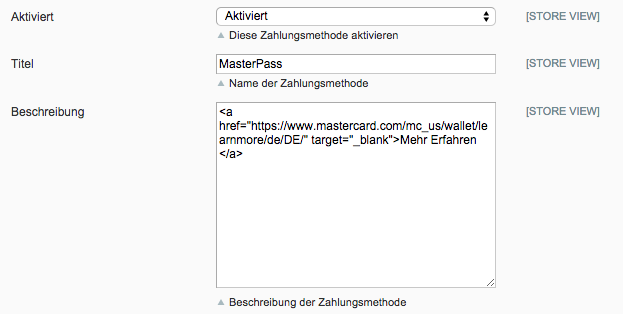
Links for additional languages can be found in this document: https://developer.mastercard.com/...
5.6.3Additional information
General and additional information on using the MasterPass trademark and logo in your webshop are available in the official MasterPass Mechant Branding Requirement Document. which you can access here: https://developer.mastercard.com/...
5.7Usage of the Ajax Authorization (FlexCheckout)
You have the possibility of processing credit cards without redirection to the payment page of Concardis PayEngine.
In order to be able to use this feature, you must first carry out the steps listed under Hidden Authorisation, FlexCheckout (Hosted Tokenization Page), External Checkout und Alias Manager and create an API-User.
You can then activate the authorisation method 'Ajax Authorization (FlexCheckout)' for the payment methods of your choice. At no time is any credit card data saved on your server.
6The Module in Action
Below you will find an overview of the most important features in the daily usage of the Concardis PayEngine module.
6.1Capturing / Canceling of Orders
6.1.1Capturing Orders
The transaction management between your shop and Concardis PayEngine is not synchronized. If you capture payments with Concardis PayEngine, the status in the shop will not be updated and a second capturing in the shop is not possible.
In order to be able to capture orders, you must make sure that you have set 'Capturing' to deferred in the configuration of the payment method.
Open the order you wish to capture and switch to the tab Transactions. Here you will find the tab Captures. Enter the amount you wish to debit from the customer's card. By clicking Capture, a direct capturing of the order occurs with Concardis PayEngine.
6.1.2Cancellation
By clicking the button Cancel, you delete the initial authorization on the customer's card. The pre-authorized amount is released from the customer's card.
6.2Useful Transaction Information on the Order
In each order, processed via our module, you can find an overview of the most important information about the transaction as well as a transaction history.
In order to get to the transaction information, open the order and switch to the tab Transactions. Here you will find all authorization attempts and the related information.
6.3Refunds
You can refund already captured transactions and automatically transmit them to Concardis PayEngine. In order to to so, open the order. Switch to the tab Transactions. A new window will open up in which you must then switch to the tab Refunds in order to refund orders.
To refund a line item you need to enter the quantity you wish to refund. By clicking Refund, the refund is automatically transmitted to Concardis PayEngine. It will than be refunded via the payment method the customer chose for the transaction.
Please note that you can't refund more than 100% of the original amount.
Executing a refund will not change the status of the order.
6.4Usage of the Alias Managers / Token Solution
With the Alias Manager, your customers can securely save their credit cards with Concardis PayEngine for later purchases. You can enable this by activating the option "Alias Manager" in the configuration of the Payment Method. The customer can then choose from his or her saved credit cards without having to re-enter all the details.
The usage of the Alias Managers requires the activation of the correct option with Concardis PayEngine. To do so, please contact the support directly.
6.5Dynamic Template
We provide a standard skin for the usage of the dynamic template for all sellxed modules. You can activate the option by setting the option "Dynamic Template" to "Use Shop Template" in the main module. Please make sure that all settings specified under Template have been carried out in the backend of Concardis PayEngine.
The Dynamic Template allows you to load the Payment Page of Concardis PayEngine in the layout of your shop. The customer, therefore, does not notice that the customer has been forwarded to the website of Concardis PayEngine. The template dynamically adjusts to your shop template. This, furthermore, allows you to easily integrate Mobile Skins (cf. Screenshots).
In order for the Dynamic Template to work correctly with all browsers, you require an SSL certificate in your shop.
6.5.1Dynamic Template Exceptions Shopware 5
Shopware Version 5 incorporates icons through an additional font. Hence, icons may not be displayed correctly on the payment page. To prevent this, please make the following changes to your server configuration:
Insert the .htaccess files on your server into the modification below. The file's location depends on the folder structure of your theme. For standard templates, the relevant files can be found in the following locations:
- /themes/Frontend/Responsive/frontend/_public/vendors/fonts/open-sans-fontface/.htaccess
- /themes/Frontend/Responsive/frontend/_public/src/fonts/.htaccess
<IfModule mod_headers.c> Header set Access-Control-Allow-Origin "*" </IfModule>
7Getting the Credit Card Data via Shopware REST API
When connecting ERP systems to Shopware it may be that further information is required via Shopware API. Our module provides you with a lot of payment information also via Shopware REST API.
Basic Information about the usage of the REST API of Shopware can be found in the Shopware Developers Guide.
The service can be called up under https://www.shop-url.com/api/CwbpayenginecwTransactions. The call of the above URL leads to the listing of all transactions. By adding the Transaction ID you can filter by the corresponding Transaction ID. The Transaction ID can be found in the order overview (Customer > Payments > Concardis PayEngine )
Additionally, you can also access the transaction via the Payment ID (transmitted through Concardis PayEngine). To do so, the parameter 'usePaymentId=1' has to be added as a parameter to the URL.
8Set-up a cron job to activate the timed operations
To activate the timed operations of the plugin (e.g. update service, deleting pending orders, etc.) make sure that you set up the Shopware Cron engine. Especially the update function allows you to automatically retrieve additional information or changes of your order directly via the API of Concardis PayEngine. For payment methods which use a delayed authorisation process this is mandatory. Please note it could be that in order to use the update feature it may be necessary that Concardis PayEngine activates additional options in your account.
The module uses the standard cron engine of Shopware. More information regarding the set up can be found here: https://community.shopware.com/Cronjobs_detail_1102.html.
9Testing
Before switching from test to live mode it is important that you test the module extensively.
Do not forget to switch the operating mode from test to live after having successfully tested the module.
9.1Test Data
In the following section you can find the test data for the various payment methods:Card number 3750 0000 000 0007 Expiry Date 12/2020 CVC 1234 | American Express |
Card number 5399 9999 9999 9999 Expiry Date 12/2020 CVC 123 | Mastercard |
Card number 4111 1111 1111 1111 Expiry Date 12/2020 CVC 123 | VISA (Without 3-D Secure Check) |
Card number 4000 0000 0000 0002 Expiry Date 12/2020 CVC 123 | VISA (With 3-D Secure Check) |
Card number 3750 0000 000 0007 Expiry Date 12/2020 CVC 1234 | American Express |
Card number 5399 9999 9999 9999 Expiry Date 12/2020 CVC 123 | Mastercard |
Card number 4000 0000 0000 0002 Expiry Date 12/2020 CVC 123 | VISA (With 3-D Secure Check) |
Card number 4111 1111 1111 1111 Expiry Date 12/2020 CVC 123 | VISA (Without 3-D Secure Check) |
10Errors and their Solutions
You can find detailed information under http://www.sellxed.com/en/faq. Should you not be able to solve your problem with the provided information, please contact us directly under: http://www.sellxed.com/en/support
10.1The Referrer URL appears in my Analytics Tool
When a customer and the notification are redirected via Header Redirection, the Concardis PayEngine Referrer URL might appear in your Analytics Tool thus hiding the original traffic source. However, most Analytic Tools are able to minimize this problem.
In case you are using Google Analytics as reporting tool, this step by step guide may help you to exclude the URLs: under bullet point 4.
11Compatibility with Third-Party Plugins
The plugins listed below are compatible with our payment modules and allow you to handle certain tasks in an easier way.
11.1Birthday and gender in Shopware
For certain payment service providers it is necessary to check the birthday and the gender of a customer. Shopware does not check this by default. To enable these checks go to "Configuration > Basic Settings > Frontend > Login / Registration" and check the following parameters:
- Show Birthday Field
- Birthday is required
- Show "I am" select field
12Error Logging
The module will log different unexpected errors or information depending on the configured level. If there is any issue with the module, this log can help identify the cause.
12.1Log Levels
You can configure the log level in the Concardis PayEngine settings.
- Error: Logs unexpected errors only. (Default)
- Info: Logs extended information.
- Debug: Logs information helpful for debugging.
12.2Log Location
The log file is stored in the Shopware log directory. Please make sure the path exists and it is writable by the webserver. (Default Path: {shopRootDirectory}/logs or {shopRootDirectory}/var/log)
13Advanced Information
This section of the manual is for advanced usage of the module. The content is for advanced users with special requirements. Everything in this section is optional and not required for the daily usage of the module.
13.1Transaction Object
This section describes how to extract information from a transaction, if you need it for further processing. E.g. you require more information of the transaction for further processing an order in your ERP system.
The code snippets in this section assume your script resides in the root folder of the shop with the default shop folder structure.
require __DIR__ . '/autoload.php'; use Shopware\Kernel; $environment = 'production'; $kernel = new Kernel($environment, false); $kernel->boot();
$pluginPath = 'engine/Shopware/Plugins/Local/Frontend/CwbPayEngineCw';
Shopware()->Loader()->registerNamespace('Customweb', 'Customweb/');
Shopware()->Loader()->registerNamespace('CwbPayEngineCw_Helpers', $pluginPath . '/Helpers/');
Shopware()->Loader()->registerNamespace('CwbPayEngineCw_Entities', $pluginPath . '/Entities/');
Shopware()->Loader()->registerNamespace('CwbPayEngineCw_Components', $pluginPath . '/Components/');
Shopware()->Loader()->registerNamespace('Shopware\Components\Api', $pluginPath . '/Components/Api/');
require_once $pluginPath . '/Library/loader.php';
Customweb_Core_Util_Class::registerClassLoader(function ($className){
return Shopware()->Loader()->loadClass($className);
});
Customweb_Core_Util_Class::registerClassLoader(function($className){
if(strpos($className, 'PayEngineCw') === 0){
$fileName = substr($className, strrpos($className, '_')+1).".php";
if(file_exists('engine/Shopware/Plugins/Local/Frontend/CwbPayEngineCw/Legacy/'.$fileName)){
require_once 'engine/Shopware/Plugins/Local/Frontend/CwbPayEngineCw/Legacy/'.$fileName;
return true;
}
}
return false;
});
$transactionById = CwbPayEngineCw_Helpers_Util::loadTransaction($transactionId); $transactionObject = $transactionById->getTransactionObject();

